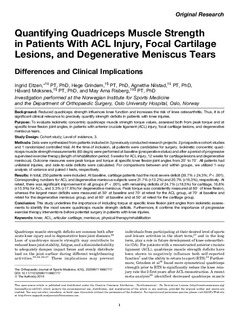| dc.description.abstract | Background: Reduced quadriceps strength influences knee function and increases the risk of knee osteoarthritis. Thus, it is of significant clinical relevance to precisely quantify strength deficits in patients with knee injuries. Purpose: To evaluate isokinetic concentric quadriceps muscle strength torque values, assessed both from peak torque and at specific knee flexion joint angles, in patients with anterior cruciate ligament (ACL) injury, focal cartilage lesions, and degenerative meniscus tears.
Study Design: Cohort study; Level of evidence, 3. Methods: Data were synthesized from patients included in 3 previously conducted research projects: 2 prospective cohort studies and 1 randomized controlled trial. At the time of inclusion, all patients were candidates for surgery. Isokinetic concentric quadriceps muscle strength measurements (60 deg/s) were performed at baseline (preoperative status) and after a period of progressive supervised exercise therapy (length of rehabilitation period: 5 weeks for ACL injury, 12 weeks for cartilage lesions and degenerative meniscus). Outcome measures were peak torque and torque at specific knee flexion joint angles from 20 to 70 . All patients had unilateral injuries, and side-to-side deficits were calculated. For comparisons between and within groups, we utilized 1-way analysis of variance and paired t tests, respectively. Results: In total, 250 patients were included. At baseline, cartilage patients had the most severe deficit (39.7% ± 24.3%; P < .001). Corresponding numbers for ACL and degenerative meniscus subjects were 21.7% (±13.2%) and 20.7% (±16.3%), respectively. At retest, there was significant improvement in all groups (P < .001), with remaining deficits of 24.7% (±18.5%) for cartilage, 16.8% (±13.9%) for ACL, and 3.3% (±17.8%) for degenerative meniscus. Peak torque was consistently measured at 60 of knee flexion, whereas the largest mean deficits were measured at 30 at baseline and 70 at retest for the ACL group, at 70 at baseline and retest for the degenerative meniscus group, and at 60 at baseline and at 50 at retest for the cartilage group. Conclusion: This study underlines the importance of including torque at specific knee flexion joint angles from isokinetic assessments to identify the most severe quadriceps muscle strength deficits. Furthermore, it confirms the importance of progressive exercise therapy interventions before potential surgery in patients with knee injuries. | nb_NO |
